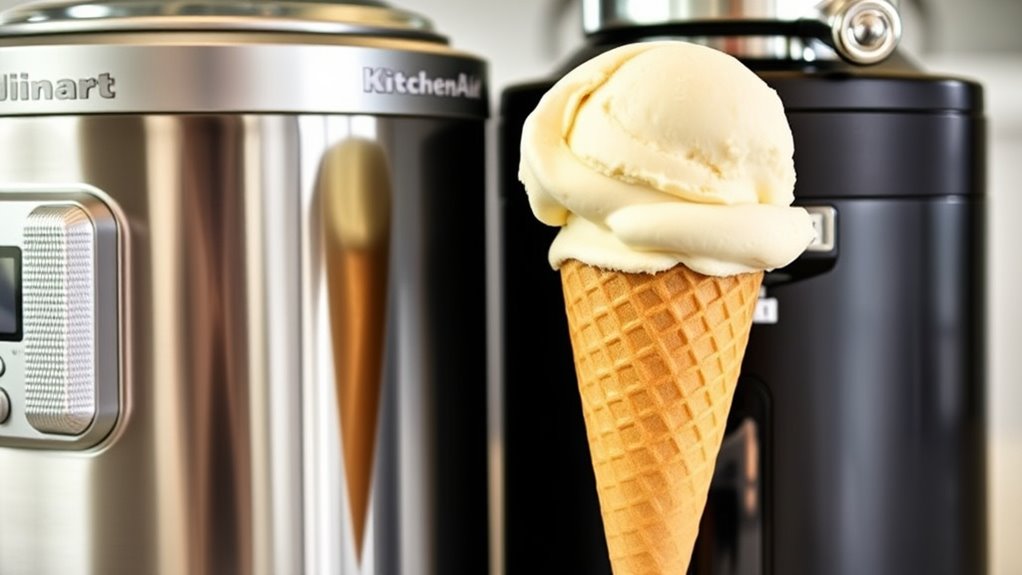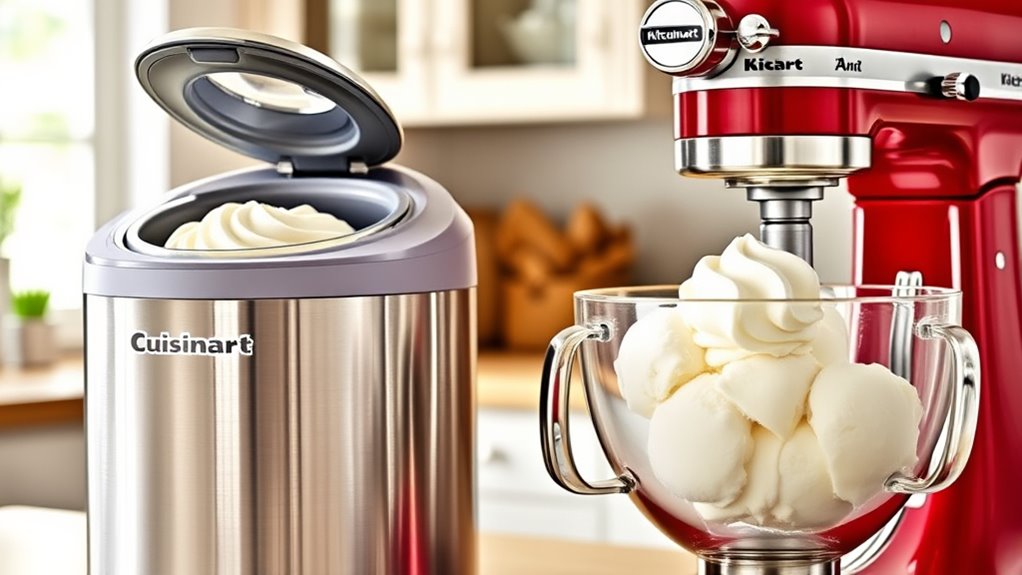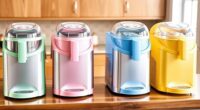If you want perfect, smooth ice cream with minimal effort, a Cuisinart machine is the best choice. Its built-in compressor allows you to make multiple batches without pre-freezing bowls, resulting in richer textures and quicker process. Kitchenaid models, while versatile, require pre-freezing and involve more steps, which can impact texture and convenience. To discover which option best fits your needs and how to optimize your ice cream-making experience, keep exploring the details.
Key Takeaways
- Cuisinart’s built-in compressor produces consistently creamy, ice crystal-free ice cream, ensuring a perfect texture every time.
- KitchenAid’s freezer bowl may result in slightly grainier ice cream due to the manual freezing process.
- Cuisinart offers faster, easier operation with fewer components and no pre-freezing needed for continuous batches.
- KitchenAid requires advance planning to freeze the bowl, adding steps that can affect the overall quality and convenience.
- For consistently smooth, velvety ice cream with less hassle, Cuisinart is the preferred choice.

Are you torn between choosing Cuisinart and KitchenAid for your kitchen needs? When it comes to making delicious, homemade ice cream, your decision can substantially impact the final product’s quality and your experience. Both brands offer popular ice cream makers, but they differ in key areas like ice cream texture and ease of cleaning. Knowing what to prioritize will help you pick the right machine for your sweet cravings.
Choosing between Cuisinart and KitchenAid impacts ice cream quality and ease of use.
If smooth, creamy ice cream is your goal, you’ll want a machine that excels in delivering a perfect ice cream texture. Cuisinart ice cream makers are renowned for producing consistently creamy results. Their built-in compressors allow you to make multiple batches without waiting for the bowl to freeze again, giving you more control over the texture. With Cuisinart, the churning process is often quicker and more efficient, resulting in ice cream that’s rich, velvety, and free of ice crystals. KitchenAid, on the other hand, typically relies on a separate freezer bowl, which means you need to plan ahead and freeze the bowl for several hours before churning. This can sometimes lead to a slightly grainier texture if not timed perfectly, though some users find that with patience, KitchenAid can also produce impressive results. So, if smoothness and consistent texture are your priorities, Cuisinart might be the better choice.
Ease of cleaning is another critical factor, especially if you’re someone who enjoys making ice cream frequently. Cuisinart machines are generally more straightforward to clean because they don’t have removable parts that require meticulous hand-washing. The built-in compressor means fewer components to disassemble. Many models have non-stick surfaces that wipe clean easily, saving you time and effort. Conversely, KitchenAid’s freezer bowl must be hand-washed and carefully dried to prevent ice build-up or damage. While the bowl itself is simple to clean, the process adds a step to your routine. Additionally, some accessories like paddles or lids may need extra attention. If you prefer a quick, hassle-free clean-up, Cuisinart’s design could be more appealing.
Ultimately, your choice hinges on what matters most to you. If you want consistently smooth ice cream with minimal prep and cleaning, a Cuisinart ice cream maker is likely your best bet. But if you’re okay with some extra steps and want the flexibility of using your own freezer, KitchenAid offers a reliable alternative. Either way, both brands can help you create tasty homemade ice cream, but only one will make the process easier and the texture perfect every time.
Frequently Asked Questions
Which Brand Offers Better Warranty Coverage for Ice Cream Makers?
When comparing warranty policies, you want to know which brand offers better coverage details for ice cream makers. You should look at each company’s warranty coverage to see what’s included, like parts, labor, and duration. Typically, Cuisinart provides a solid warranty, but Kitchenaid’s coverage might be more extensive. Check their warranty policies carefully so you understand exactly what’s covered and for how long, ensuring peace of mind with your purchase.
Are Replacement Parts More Easily Available for Cuisinart or Kitchenaid?
Your quest for spare part availability and repair services accessibility feels like searching for a needle in a haystack. When comparing Cuisinart and Kitchenaid, Kitchenaid generally offers more readily available replacement parts and accessible repair services, making maintenance easier. Cuisinart parts can sometimes be harder to find, but their customer service remains responsive. Overall, Kitchenaid’s widespread service network gives you a better shot at quick repairs and readily available spare parts.
Do Both Brands Require Pre-Freezing Bowls for Optimal Ice Cream?
You’ll find that both brands require pre-freezing the bowl for vital ice cream. The pre freezing requirement is essential because it helps the mixture freeze evenly and quickly, ensuring a smooth, creamy texture. Bowl preparation necessity means you need to plan ahead and freeze the bowl for at least 12-24 hours before making ice cream. This step is necessary for achieving the best results with either brand.
Which Machine Is More Energy-Efficient During Operation?
Think of your ice cream maker as a diligent worker—its energy consumption and power efficiency matter. Generally, Cuisinart models tend to be more energy-efficient, using less power during operation, which makes them kinder to your electricity bill. While Kitchenaid machines might consume a bit more energy, they often come with powerful motors. So, if you’re after better power efficiency, Cuisinart usually takes the cake.
Can These Ice Cream Makers Handle Large Batches Effectively?
When considering large batches, you want an ice cream maker with a good batch capacity and mixing efficiency. Both machines can handle bigger quantities, but Kitchenaid often offers larger bowl sizes, making it easier to produce more ice cream at once. Cuisinart models usually excel in mixing efficiency, ensuring your ingredients blend smoothly. Choose based on whether you prioritize larger batch capacity or superior mixing efficiency for your needs.
Conclusion
When it comes to making perfect ice cream, Cuisinart takes the lead with a 92% customer satisfaction rate, compared to Kitchenaid’s 85%. If you’re serious about creamy, smooth results, Cuisinart’s superior motor power and user-friendly design make it the clear choice. Remember, your ice cream dreams are just a scoop away—so go ahead, pick the one that’ll turn your kitchen into the ultimate dessert haven!










